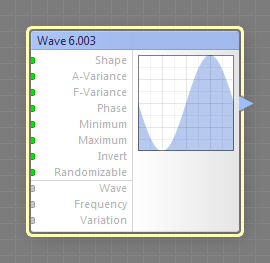
This component is obsolete and its use in filters is not recommended. Use the recent version of the component.
The Wave component generates a periodic sine, rectangular, triangular or absolute sine wave with randomizable amplitude and frequency. The algorithm used in this component is based upon (Schlick 1995) Schlick, Christophe, "Wave Generators for Computer Graphics", Graphics Gems V, ed. Alan W. Paeth, Academic Press, pp. 367-374, 1995. This is a curve component, it can be located in the Curves category on the Components Bar.
Shape: Map Input
Adjusts the shape of each wave segment. Technically, this is done by remapping the amplitude of each wave segment with a Bias curve. Since Shape is a map input, its value can be controlled separately for different image areas by connecting a map component to this input.
A-Variance: Map Input
Controls the amount of randomization applied to the wave amplitude. The randomization is performed by decreasing the amplitude of each wave 'peak' by a random amount. When this parameter is set to 0, no randomization is performed. When set to 100, the amplitude of peaks varies within half the output range specified by the Minimum and Maximum parameters. Since A-Variance is a map input, its value can be controlled separately for different image areas by connecting a map component to this input.
F-Variance: Map Input
Controls the amount of randomization applied to the wave frequency. The randomization is performed by shifting each wave peak leftwards or rightwards by a random amount. When this parameter is set to 0, no randomization is performed. Since F-Variance is a map input, its value can be controlled separately for different image areas by connecting a map component to this input.
Phase: Map Input
Defines the amount of phase shift. Negative values shift the curve leftwards, while positive values shift it rightwards. The maximum amount of phase shift is half the length of a wave period (the distance between two wave peaks when F-Variance is set to 0). To shift the phase by greater amounts, use the Phase component. Since Phase is a map input, its value can be controlled separately for different image areas by connecting a map component to this input.
Minimum and Maximum: Map Inputs
Minimum and Maximum define the output range of the curve. When the Minimum value is greater than the Maximum value, they get reversed – the Minimum parameter defines the Maximum value and vice versa. This is needed to avoid turning the curve upside down. Since Minimum and Maximum are map inputs, their values can be controlled separately for different image areas by connecting a map component to any of these inputs.
Invert: Map Input
Inverts the curve, converting its value at each point to its opposite: 0.05 to 0.95, 0.25 to 0.75 etc. Invert is applied to the curve before Minimum and Maximum take effect, so they still define the output range correctly. When a map component is connected to this input, the state of the checkbox is determined separately for different image areas by the brightness level of the image supplied by that component. The brightness level of 0 to 50 corresponds to unchecked Invert, and the level of 50 to 100 corresponds to checked Invert.
Randomizable: Map Input
When turned on, the global Variation parameter will affect the curve generated by the component. When this parameter is turned off, the global Variation has no effect on the curve. This may come in useful when you would like to 'lock' the appearance of the curve and don't want the global Variation to change it. When a map component is connected to this input, the state of the checkbox is determined separately for different image areas by the brightness level of the image supplied by that component. The brightness level of 0 to 50 corresponds to unchecked Randomizable, and the level of 50 to 100 corresponds to checked Randomizable.
Determines the wave shape: Sine, Rectangle, Triangle, or Bounce (Bounce is based on an absolute sine wave).
Adjusts the wave frequency, i.e. the number of wave periods within the visible range of the curve. The actual number of periods is also affected by the F-Variance parameter. Frequency of 0 produces a constant function ('flatline'). This parameter accepts fractional values. Since Frequency is not a map input, it doesn't allow to adjust the frequency for different image areas separately. To do this, you can use the Frequency component.
Variation, technically known as random seed, affects the random aspects of the component which cannot be controlled directly: it randomizes the amount of amplitude and frequency offset within the ranges specified by A-Variance and F-Variance. When these two parameters are set to 0, Variation has no effect. If the Randomizable parameter is turned on, the randomization is also affected by the global Variation value. For more information, see How Variation Works.